Chefs’ Collective members Angie Rito and Scott Tacinelli have the sweetest meet-cute tale we’ve heard in a while. He was in the kitchen, she was at front of house at the legendary New York City restaurant Park Avenue. “I thought she was so cute, I couldn’t take it,” recalls Scott in the duo’s new cookbook.
Their first date was quickly followed by a three-week whirlwind tour of eating their way through Spain, staying in hostels. Angie—a veteran of family restaurants who quickly realized she should be cooking, too—was in love. Pretty soon they partnered to cook together at Quality Italian, and then again at a pop-up restaurant in a bar called dinnertable. Lines formed down the block, in part because of the buzz around their iconic “pinwheel lasagna.”
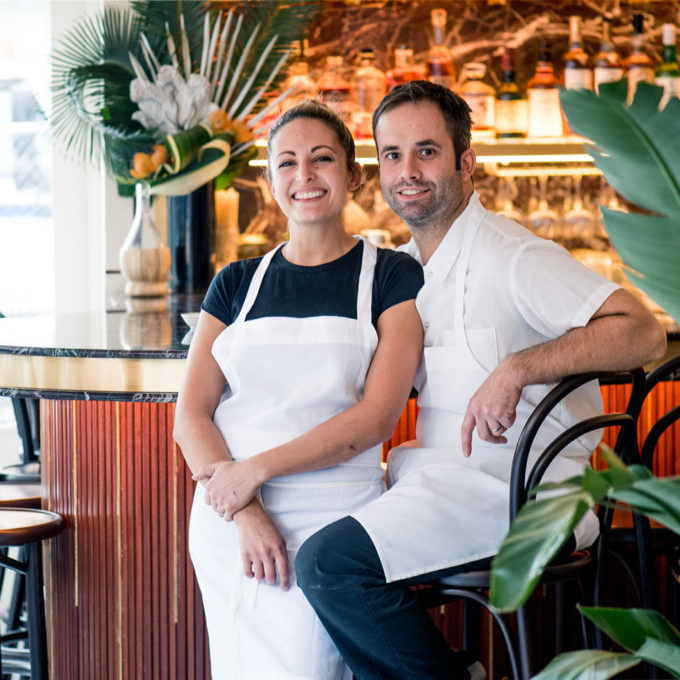
Scott and Angie are now married and run the show at their restaurant, Don Angie. The restaurant received its first Michelin star this year, snagged two-star reviews from The New York Times and Eater NY, was named one of Esquire’s Best New Restaurants in America, and the two chefs together received a 2019 James Beard Award nomination for Best Chef New York City.
Today, they have a restaurant, a sweet little bambino, and a new cookbook, Italian American. In its honor, we’re sharing that incredible pinwheel lasagna, below, which is a hit at Don Angie. It’s the sort of dish you serve to friends… and then become the talk of your neighborhood.
Don Angie Pinwheel Lasagna
We came up with this recipe while brainstorming how to make a pasta dish for two, and landed on lasagna because it’s the ultimate crowd-pleaser, the king of all baked pastas, the most impressive thing we could think of. We are not ashamed to admit that the idea for presenting it this way came from a photo of baked cinnamon buns in a pan, though we later learned that there is in fact a classic, pinwheel-shaped pasta dish that exists in Italy, called rotolo. We wanted to make this version taste like classic lasagna, and pulled in all the flavors of a true lasagna Bolognese—fresh pasta, besciamella, Bolognese sauce—and added some Italian-American twists of our own (i.e., mozzarella, tomato sauce, sweet Italian sausage). In its finished form, this is the perfect amalgamation of regional Italian and Italian-American cuisine, with a unique presentation that’s helped make this one of our most-requested dishes at the restaurant.
It’s perfect for sharing, because each person gets a pinwheel, and the whole top is crispy, so every bite is perfect. And because the pasta is rolled around the filling, instead of stacked and compacted, it feels lighter than most lasagnas. Diehard regional Italian connoisseurs will say this isn’t a “real” lasagna, in the traditional sense, but nothing we do is, and we don’t claim it to be. This is just us doing our thing.
Makes 16 Pinwheels (Serves 8 to 10)
Kosher salt, for the pasta water
Northern-Style Egg Yolk Pasta or 8 store-bought fresh pasta sheets (12 × 7 inches)
1 cup plus 3 tablespoons Besciamella, chilled (recipe follows)
4 cups shredded whole-milk mozzarella cheese
1 cup finely grated Parmigiano-Reggiano cheese
4 cups Italian Sausage Bolognese, chilled (recipe follows)
2 cups 10-Minute San Marzano Tomato Sauce, chilled (recipe follows)
½ cup robiolina cheese or whipped cream cheese
2 tablespoons roughly chopped parsley
3 tablespoons extra-virgin olive oil, for finishing
In a large pot, bring 4 quarts water and 1 cup kosher salt to a boil over high heat. Meanwhile, set up an ice bath in a large bowl. Line a sheet pan with parchment paper.
Working with one sheet at a time, place a pasta sheet in the boiling water for 15 seconds, then immediately remove and chill in the ice bath for 15 seconds. Transfer to the lined sheet pan and pat dry with a paper towel. Cover with another layer of parchment paper and repeat with the remaining pasta, creating a stack of sheets, each patted dry and each layer separated by parchment.
On a clean countertop, lay out one pasta sheet with a short side facing you (the sheet should look like a portrait shot). Spread ¼ cup of the besciamella in a thin layer evenly across the sheet. Sprinkle 1 cup of the mozzarella and ¼ cup of parmesan over the besciamella.
Place another sheet of pasta on top. Spread 1 cup of the Bolognese evenly across the second pasta sheet, leaving a 2-inch border uncovered at the top short edge. Spoon 2 teaspoons of the besciamella onto the uncovered edge (this will act like your “glue” to seal the roll closed).
Starting at the bottom, roll up the layered pasta into a thick log (like a jelly roll). Transfer to a small sheet pan seam-side down. Place in the refrigerator to chill for at least 1 and up to 2 hours, which will firm it up and make it easier to slice.
Repeat the process with the remaining pasta sheets to make a total of 4 rolls, transferring to the refrigerator as you finish each roll. (The rolls can be tightly wrapped in plastic at this point and refrigerated for up to 2 days, or frozen for up to 3 months, before cooking. If frozen, thaw in the refrigerator before slicing.)
Preheat the oven to 400°F. Transfer the rolls to a cutting board. Using a serrated knife, slice each log in half crosswise, then slice each half in half to give you 4 slices per roll, each about 1¾ inches thick.
Ladle all of the tomato sauce into a 9 × 13-inch baking dish, covering the entire bottom of the dish. Arrange the lasagna pinwheels cut-side down in the baking dish, 4 pinwheels across in one direction and 4 across in the other. (All 16 pieces should fit in one layer, gently staggered to fit.)
Bake until the pasta edges are golden brown, 20 to 25 minutes. Remove the baking dish from the oven and add tablespoon-sized dollops of robiolina in between the pinwheels in a random pattern. Return to the oven and bake until the robiolina is warm and melted, an additional 2 to 3 minutes. Top with chopped parsley and olive oil.
Serve immediately. Leftovers keep, refrigerated, for up to 4 days.
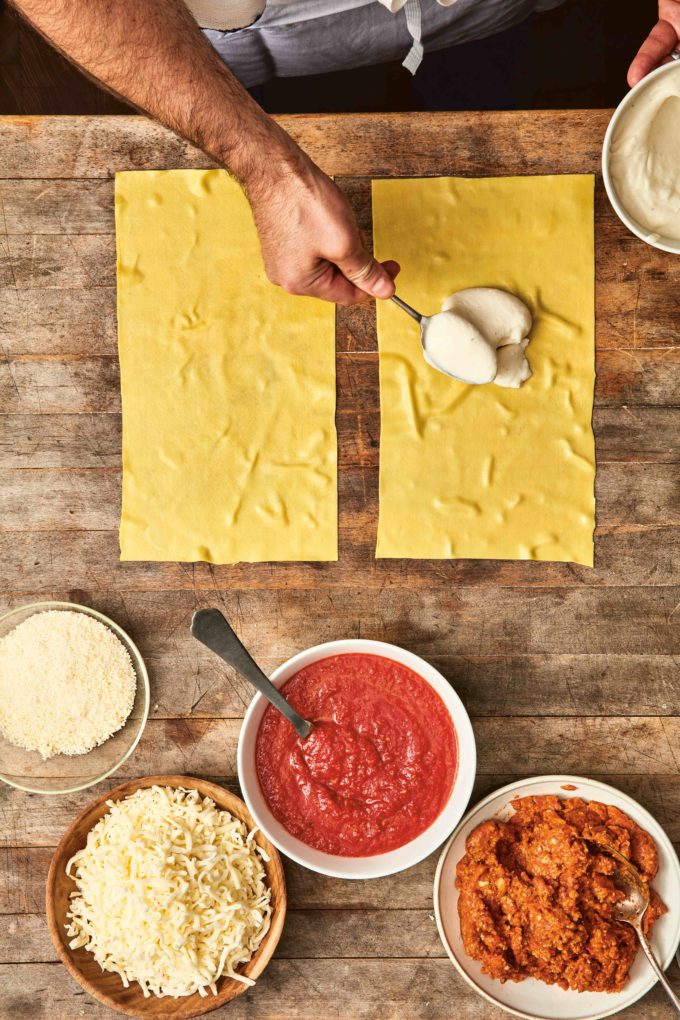
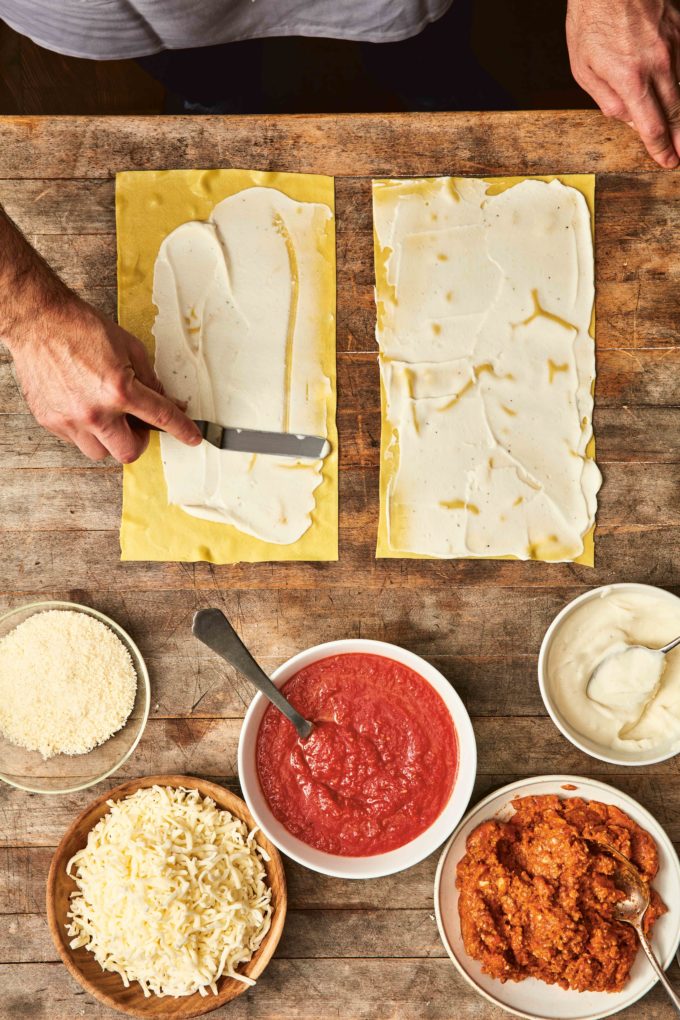
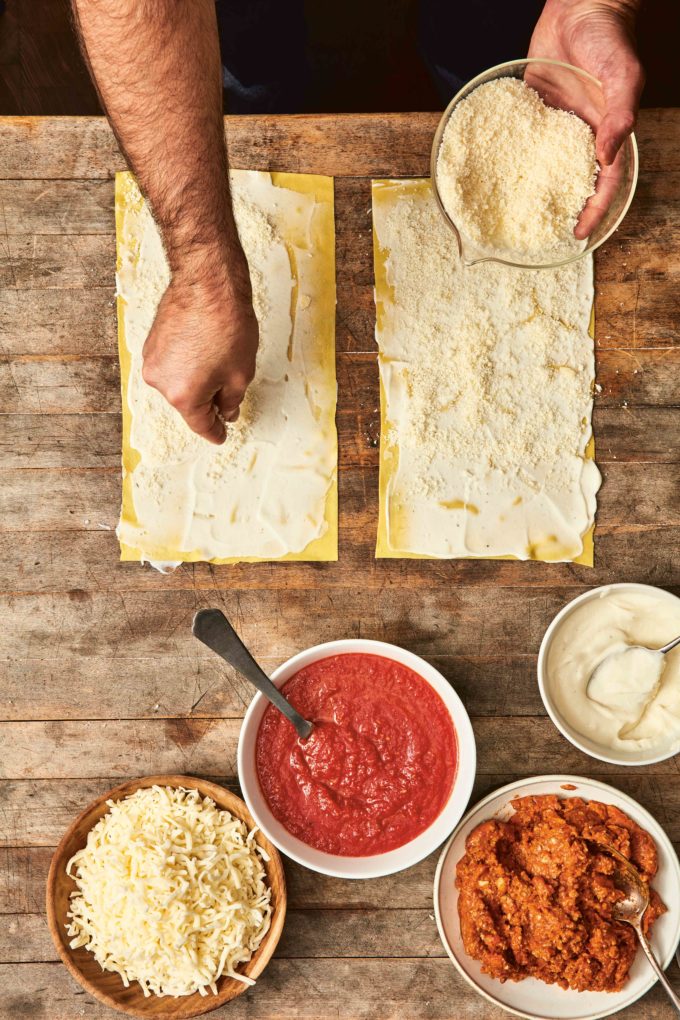
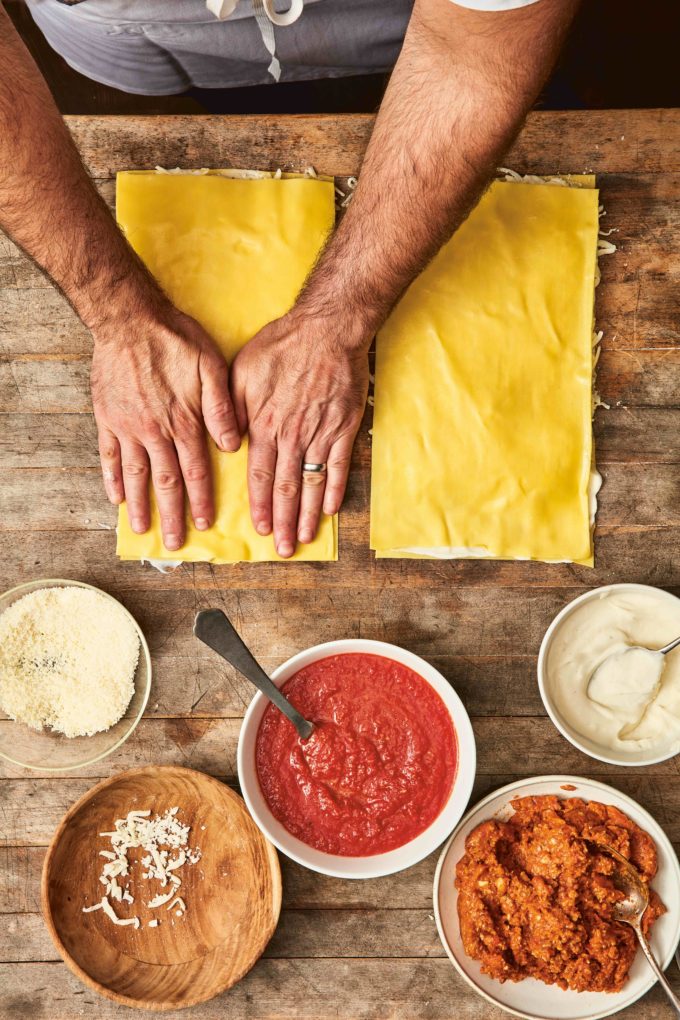
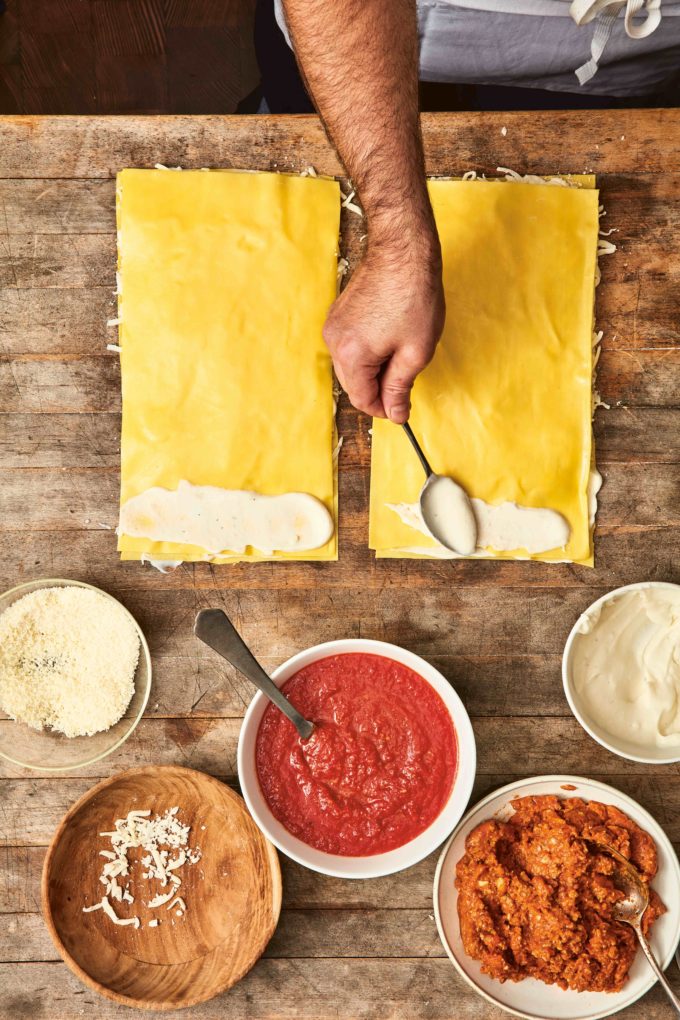
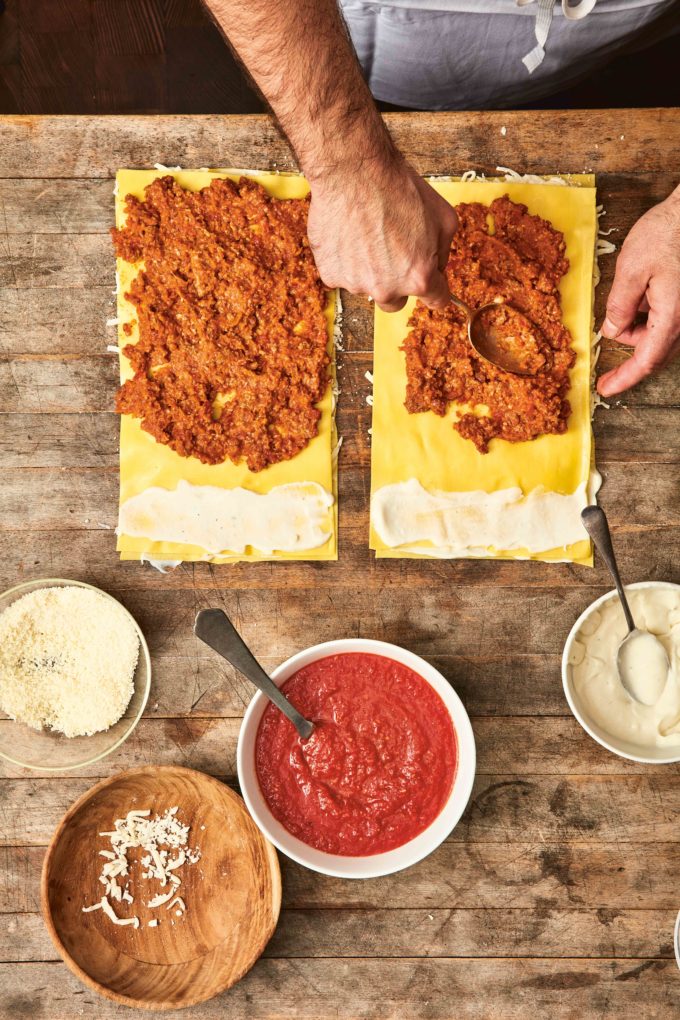
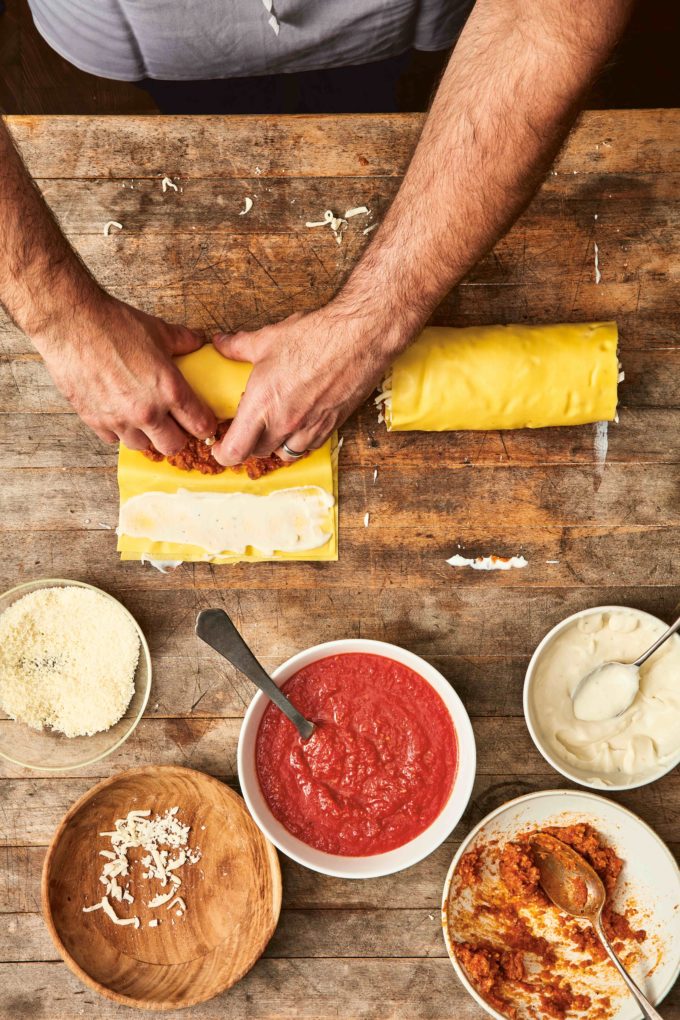
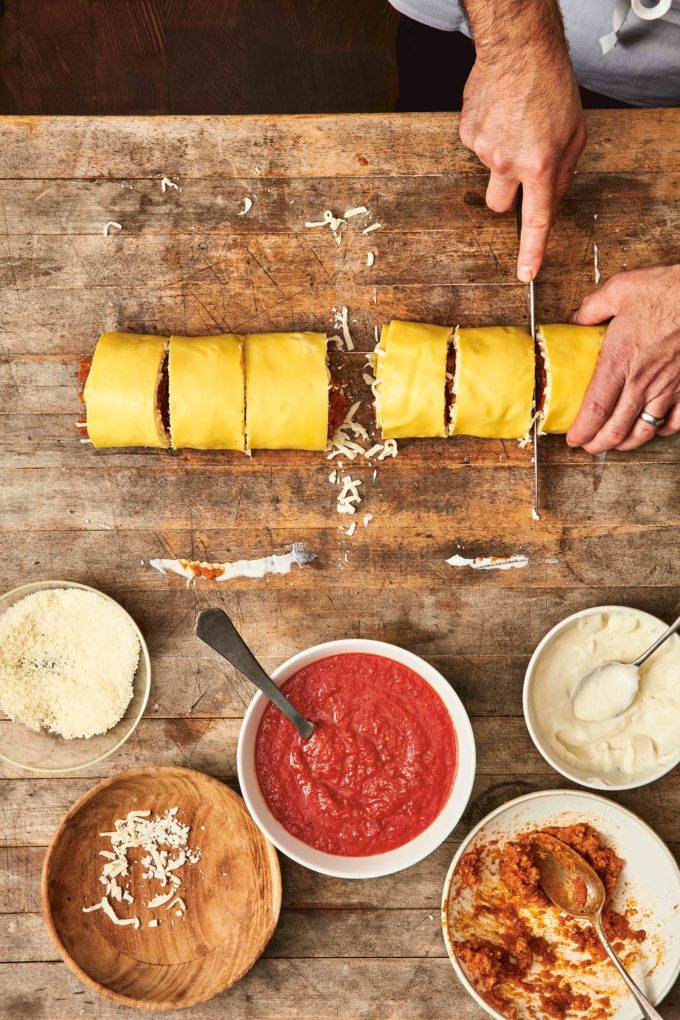
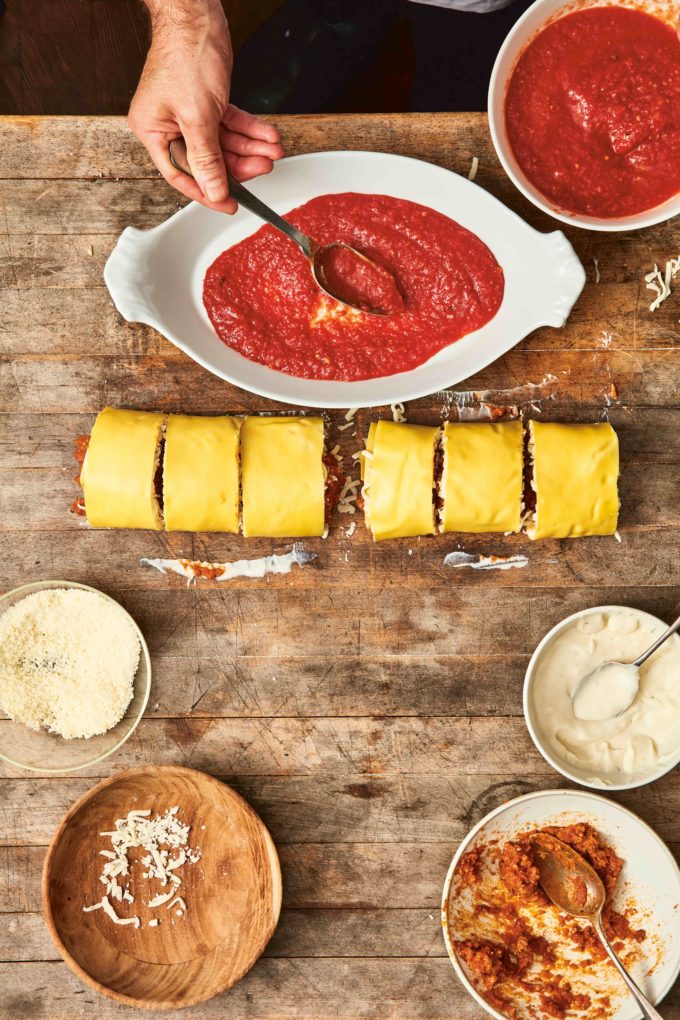
Besciamella
Makes about 2 1/2 cups
½ cup (1 stick) unsalted butter, cubed
1 head garlic, halved horizontally
⅓ cup thinly sliced shallots (about 1 medium shallot)
1 bay leaf
1 thyme sprig
¼ teaspoon black peppercorns
1 teaspoon kosher salt
½ cup all-purpose flour, “00” flour, or Wondra
2 cups cold whole milk
In a small heavy-bottomed pot, melt the butter over medium heat. Add the garlic, shallots, bay leaf, thyme, peppercorns, and salt. Cook over low heat until the shallots are translucent, about 2 minutes.
Add the flour and stir well. Increase the heat to medium and cook, stirring continually with a wooden spoon or silicone spatula, until the flour forms a smooth paste and turns lightly golden brown, about 5 minutes. Stir in the milk and cook for 5 minutes, stirring continually, until the besciamella is thick enough to coat the back of a spoon. Remove from the heat and strain through a fine-mesh sieve.
Place in the refrigerator to cool. Besciamella keeps, tightly covered in the refrigerator, for up to 3 days, or in the freezer for up to 3 months. Makes about 2½ cups.
Italian Sausage Bolognese
Makes 8 to 10 cups (Serves 8 to 10 with pasta)
2 yellow onions, coarsely chopped
4 garlic cloves, peeled
5 celery ribs, coarsely chopped
2 carrots, coarsely chopped
4 ounces pancetta, cut into 1-inch cubes
1 pound sweet Italian sausage, casings removed
1 pound ground veal
3 tablespoons kosher salt
2 tablespoons extra-virgin olive oil
½ cup tomato paste
1 cup white wine
2 (28-ounce) cans whole tomatoes (preferably San Marzano DOP)
2 cups whole milk
2 whole star anise
2 teaspoons colatura or fish sauce, plus more to taste
1 tablespoon sugar
2 tablespoons fresh lemon juice
In a food processor, working in batches if necessary, process the onions, garlic, celery, and carrots until chopped as finely as possible, similar in size to uncooked rice. Set aside. Rinse the food processor and process the pancetta until very finely chopped, the same size as the vegetables. Set aside.
In a medium bowl, mix the Italian sausage and veal together and season with the salt.
In a large heavy-bottomed pot, heat the olive oil over high heat. When it shimmers, add the meat, stirring frequently with a wooden spoon to break it up into small pieces, until evenly browned, about 15 minutes. Remove the meat with a slotted spoon and set aside. Drain any excess fat from the pot but keep the browned bits on the bottom (do not wash).
Add the pancetta to the pot over medium heat and cook, stirring occasionally, until the fat is rendered and the pancetta is browned, 8 to 10 minutes. Add the processed vegetables and cook, stirring often, until the vegetables are very soft and have taken on a darker hue, 10 to 15 minutes. Add the tomato paste and cook, continuing to stir, for 5 minutes, until deep orange and caramelized. Stir in the wine and cook until fully evaporated, about 5 minutes.
Meanwhile, using your hands, crush the tomatoes (including the liquid) over a medium bowl until completely broken up.
Return the ground meat to the pot. Add the milk, star anise, and tomatoes. Stir well, bring to a simmer, and cook over medium-low heat, uncovered, stirring occasionally, until the sauce thickens and is bright orange, about 2 hours. If any fat separates, whisk it back in to emulsify. Discard the star anise. Remove the pot from the heat and add the colatura, sugar, and lemon juice and stir well to incorporate and re-emulsify the sauce.
The sauce is ready to be used at this point, or it can be stored in an airtight container in the refrigerator for up to 1 week, or in the freezer for up to 3 months.
10-Minute San Marzano Tomato Sauce
Makes about 7 cups (Serves 4 to 6 with pasta)
2 (28-ounce) cans whole San Marzano tomatoes (make sure they are labeled DOP)
½ cup extra-virgin olive oil
8 garlic cloves, smashed with the flat side of a chef’s knife
1 tablespoon plus
1 teaspoon kosher salt
¼ teaspoon crushed red pepper flakes
1 tablespoon sugar
2 sprigs basil
In a food processor, pulse the tomatoes (including the liquid) until they’re broken up but still chunky (you’ll have about 7 cups). You can also do this with your hands, though it will produce a chunkier sauce (not a bad thing!). In a medium pot, heat the olive oil over medium-high heat until shimmering. Add the garlic and salt and cook, stirring occasionally, until the garlic is golden and fragrant, about 2 minutes. Add the pepper flakes and stir. Stir in the tomatoes and cook until the sauce comes to a boil, 1 to 2 minutes. Immediately remove from the heat and season with the sugar, then stir in the basil sprigs.
Let the basil steep in the sauce for at least 5 minutes and up to 30 minutes, then remove the basil and garlic from the sauce before serving. The sauce is ready to be used at this point, or it can be stored in an airtight container in the refrigerator for up to 1 week, or in the freezer for up to 3 months.
Reprinted with permission from Italian American by Angie Rito and Scott Tacinelli. Copyright © 2021. Photographs by Christopher Testani. Published by Clarkson Potter, an imprint of Penguin Random House.

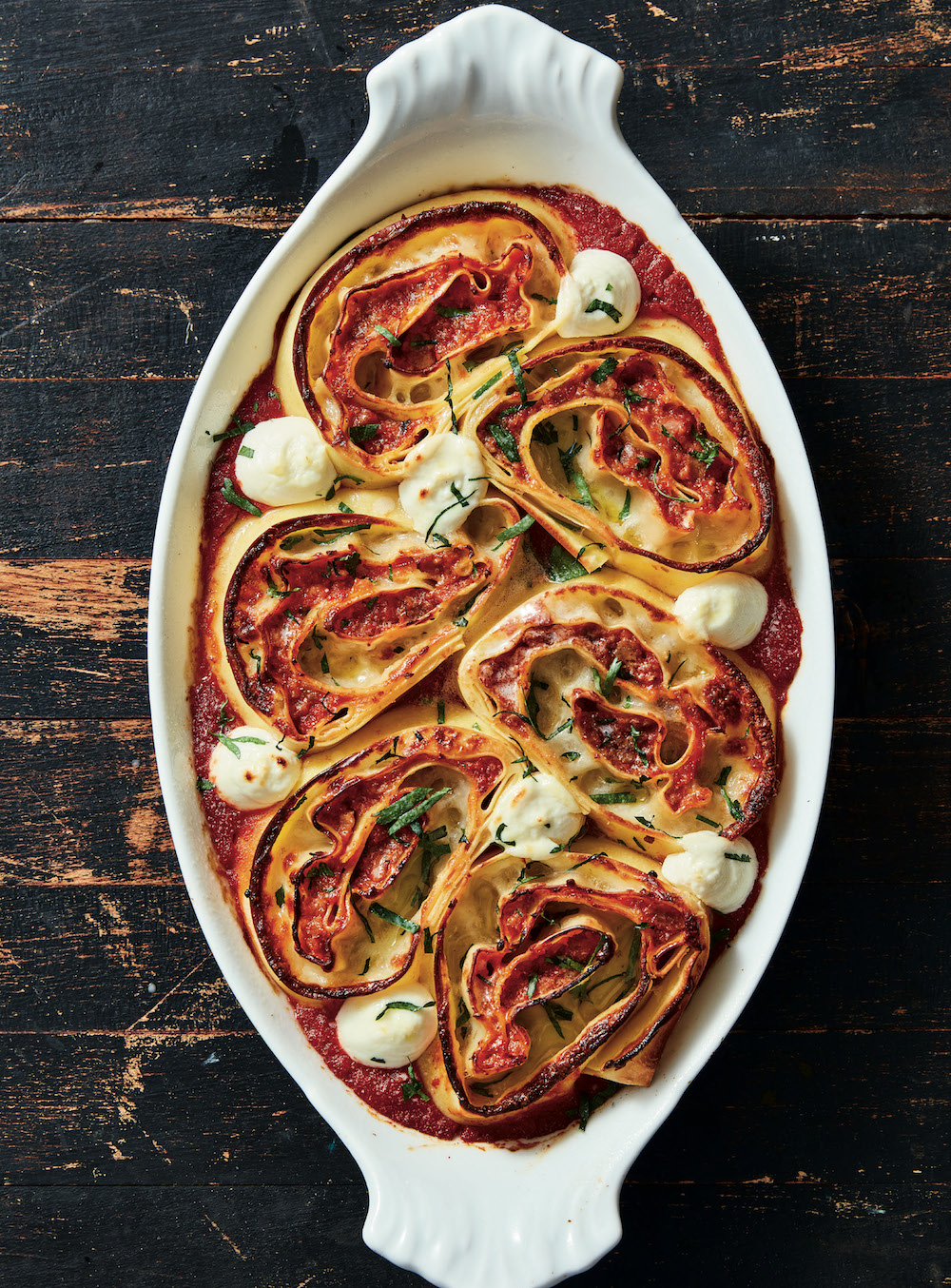
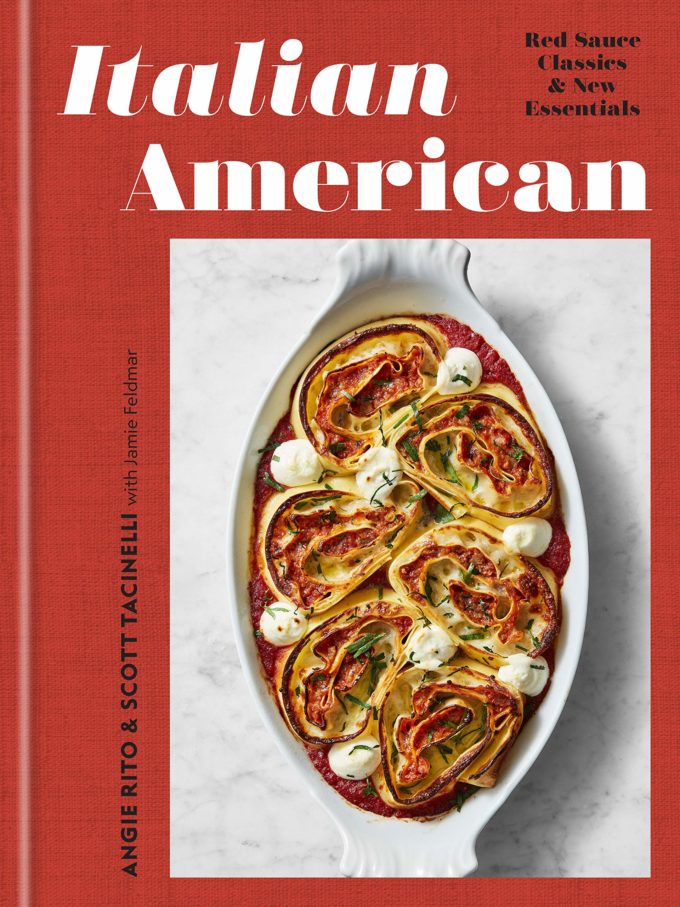
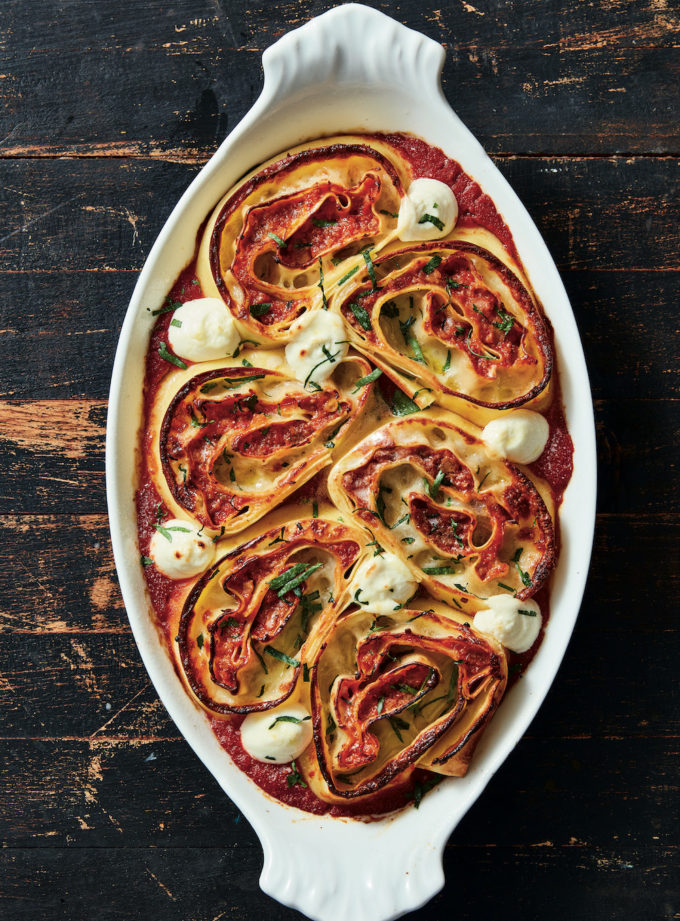
11 comments
Looks like recipe wasn’t finished . The assembly instructions were left out .
Oh my gosh! You’re right. The instructions have been added in full. Thanks for letting us know!
Recipe looks wonderful and I plan to make it!
I may be missing it but I don’t see the final assembly, what temperature to put the oven on, and how long to cook. Can you help me?
mary anne
Thanks so much for letting us know! The full instructions have been included 🙂
Thank you for the recipe, but it is not complete. It stops at refrigerating the rolls, no instructions for dish assembling or baking. Can you please modify? Thank you!
Thanks for letting us know! The full instructions have been included. Thanks!
This looks amazing!
This sounds amazing, but you left out some of the recipe. What temperature and for how long do I bake it?
All of the instructions are in! Thanks for letting us know.
How do you assemble the dish, what temperature do you cook at, and for how long?
Sorry Patty! All of the instructions have been included. Thanks for letting us know.